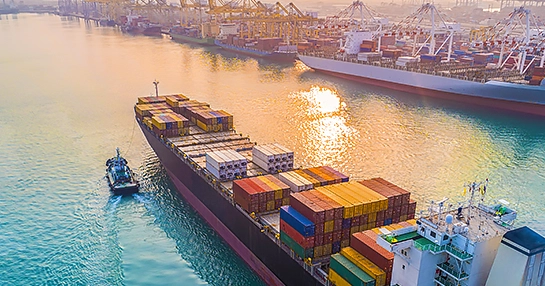Continuing the "Covid Response Series, GEP Insights sat down with Vengat N. , VP Consulting, to discuss the ongoing work in developing responses to the Covid crisis with a focus on Manufacturing industries
Speaker:

Vengat N.
Vice President

Paul Blake
Director
Paul: This is GEP Insights. I’m Paul Blake. Welcome to the conversation. With me to discuss what we should be doing in these unprecedented times in the series of Coronavirus response podcasts is my colleague, Vengat N, a very experienced member of the GEP team with a lot of insights into how companies can and should navigate their way through the coming weeks and how they might develop the tactical and strategic responses to the pandemic. So Vengat, welcome. It is good to be speaking to you today.
Vengat: Thank you, Paul. Happy to be here.
Paul: Could you begin by telling us little bit about you and your area of specialization?
Vengat: Sure. I work as Vice President of GEP, co-leading the automotive and industrial manufacturing practice. I have led and been through several procurement and supply chain transformation journeys. Looking forward to our discussion today, Paul.
Paul: Thank you, Vengat. So, these are obviously unprecedented times. From what you can see so far on the impact of the Coronavirus pandemic on businesses those that you are dealing with, what are the key things that companies should have at the top of mind right now?
Vengat: As a practitioner and leader, I am sure several things are on your mind. Address your immediate challenges. The first and foremost is employee safety; ensure CDC recommendations are followed; provide infrastructure for people who work from home; provide protective gear and wellness items, especially for people who are exposed to unknown customers and who work in distribution centers. It’s very important to create multi-channel communication to provide inputs and receive feedback from employees. Also, have flexible policies to care for the affected family members, friends and community. That's very much needed in these testing times.
Paul: So you're seeing the best in class organizations you are working with rapidly ramping up these kinds of internal capabilities almost overnight?
Vengat: Absolutely, Paul. Irrespective of the size of the organization, many of them have implemented these policies, while some have gone above and beyond. There are a few who could take more precautions where the footfall is high, such as retail stores and the online store warehouses. At few places I have seen, they limit the number of customers who can shop at a time. Now, it’s a good practice to follow.
Paul: Ok. That all said, what about the core business — the business as usual so to speak, as vitally important as it is to protect ourselves to protect our employees individually, we've also got to continue to do business? What should companies be doing at the same time as they're trying to secure their workforce to ensure business continuity?
Vengat: Not only our lives, our livelihood is also at stake. Life goes on. The next thing I can think of is the continuity of supply followed by safety. Situation changes almost every hour of the day. And the CDC is forecasting that hundreds of thousands of people are going to get affected. And it is going to be a logistical challenge for medics to have the testing kit, protective equipment and ventilators. There are companies who are extending the olive branch by converting their existing facility to make masks. And there are companies investing in low-cost ventilators, and there is a lot of collaboration between various companies to accelerate the development. Some companies are leveraging 3D printing to develop masks. And one I remember is Copper 3D where they have released the FTL digital files and assembly guidelines to print masks yourself. Specifically for businesses, I would say analyze the situation. It is important to consider the nature of your product, meaning the consumers continue to consume or replenish during the scenario for essential items like medical items, food consumables, toilet papers and the likes. Or, if your product is more like durables such as home goods and automobiles, accordingly you got to tailor your actions.
Paul: One topic that has been regularly discussed over the last couple of years has been how companies need to be increasingly able to deal with unexpected changes in global situations, changes in consumer demand, political and global trade rules, and so on…the kinds of things we've seen emerging over the last few years. Not only is this situation unexpected but rather than some tariff or political environment that has to be factored in over time, it's a major negative disruptor an unforeseen and unpleasant situation. The idea that companies need to be more agile and more adept at responding is suddenly being put to the test. Would you agree?
Vengat: Certainly, Paul. The notion that just speed and cost-effective supply chain are the best is being challenged. What would be appreciated more in addition to speed and cost is agility, adaptability and a common or shared interest throughout the supply chain would be the key. You know, here what we mean by agility is ability to react to sudden changes such as supply, demand or any other fluctuation…how well are we prepared. By Adaptability, I mean your business has to adapt to changing customer needs. I’ll give an example before that. Shared interest between the supplier and customer also will win the day. If you look at these things, some industries have learned, and many have not. The example I was going to give was that of the grocery industry, which has shown these qualities in the recent past. The way in which they handle the spike and the subsequent response showed their ability. Now, the changing market space they are playing, especially the retail space where online grocery was fairly a developing market; but in the last few weeks, there was a huge spike and they were able to adapt and respond to the customer needs despite several challenges where there was no tested solution.
Paul: Now, indeed, understandably there's been a complete breakdown in the supply chain for certain commodities to panic buying and the holding of various consumer products and so on that's been going on. And this meant the immediate supply chain for those has been unable to cope with the demand spike as you said. But what do organizations need to take away from this? Constantly replenishing a massive spike in demand isn't sustainable surely, but it might be also naive to think that things would return to normal and stay there, or this is a one-off or once in a century event. What do companies need to do to mitigate certain situations when they arise in the future?
Vengat: Sure, the Coronavirus story will undoubtedly add to our knowledge about dealing with large-scale supply chain disruptions, but the crisis is not over yet. However, we can draw important lessons about managing crisis of this nature that could be applied down the road to create a solid foundation by mapping your existing supply chain. Know your upstream suppliers, know as far as the tier 2, tier 3 suppliers, as far you can go back, failing which you would be at loss to estimate a likely impact and there is no way you can mitigate if you don’t know what is at risk. And understand your real demand, differentiate any spike that is used by one-time event such as panic buying which we saw a few weeks ago, pay special attention to the bullwhip effect in which unstable buyer behavior is going to cause fluctuations further up the chain…and that could be detrimental. Understand your vulnerabilities and take action to spread the risk. Check if your supply chains have dependencies that put your firm at risk. You know one of my clients was procuring a flavor that goes into many of their largest selling squeeze and the supplier could manufacture the squeeze in only one of their locations. This was not known until the supply was disrupted due to hurricane Sandy. You know as recent as I admired Apple’s supply chain, but it got exposed when China was short. Identify your vulnerabilities and create a business continuity plan and it should contain contingencies in critical areas and include backup plans for people, facility, transportation, supply and importantly cash flow. Involve your suppliers and customers while developing these plans and that will make it very strong.
Paul: You mentioned cash flow. Surely, cash on hand is also got to be a key consideration right now I would have thought.
Vengat: Absolutely. You are right, Paul. Cash is king, especially in this scenario. As the crisis deepens, constrained supply chains, slow phase, pressure on margin will add more weight and liquidity. And it is very important if your company is high in debt. You have three key elements to call out – accounts payable, accounts receivable and inventory. Normally, the leaders of the company focus on income statement; however, in the current scenario, the focus should be more on balance sheet. One easy and tempting approach is to increase the payment terms of your suppliers. However, you need to understand that your suppliers are facing the same adverse conditions. You know the best thing is to have a conversation about the business scenario, especially with small-scale suppliers, and see how they can help or provide them some relief by reducing their payment terms. Be a good supplier and a good customer. Moving on, supply chain teams should focus on optimizing the inventory, which includes raw material, work in process and finished goods. Take measured steps to focus on all these three areas and keep a close tab on the cash flow. Another option is to explore supply chain financing options; it will really cut your capital investment plans and see if you can convert your fixed cost to variable cost wherever possible. All said and done, this crisis is certainly going to get over. Until then, the major goal is to ensure to stay afloat.
Paul: Yes, it seems to me that good communication and collaboration between partners in the supply chain is really critical in order to minimize that negative impact now more than ever. In your estimation, what are the best practices then in that regard? Is it about constant communication? Is it about relaxing the terms of business as you said? And if so, what are the longer-term implications? Are we looking at a restructuring of supplier relationships that will go into longer term?
Vengat: Yes. The absolute partnership between suppliers and customers are needed more than ever. There is a lot of interdependence today between businesses. D&B data indicates that 50,000 companies worldwide have tier 1 or direct suppliers in the impacted region of China. I am just talking about one particular region to show the magnitude. And what’s more interesting though is as you start looking further down the supply chain, the tier 2 suppliers grow that number to 5 million globally that have impacted suppliers in that particular region of China. So, in this scenario, the information exchange and mutual sharing could be extremely beneficial to all involved. Your behavior in these circumstances could structurally change the way you do business with your suppliers and vice-versa. It’s a great opportunity to act as an extension of your supplier company by sharing information and resources which could benefit both the sides.
Paul: Procurement teams have had a singular focus which has been on savings and cost reduction. This was I think the genesis of procurement as an operation; but in more recent times with the advent of new technology and a greater maturity in the whole procurement profession, it seems to me that leading edge companies have started to branch out and look more than simple cost reductions, savings and started to pay more attention to efficiencies to supplier innovation to collaboration…those kind of things we have been talking about. And they'll be developing a more sophisticated practice — more sophisticated operations for adding value than just focusing on cost reduction. I want to know if that all gets pushed to the side, should that now be parked, and all of those new areas of exploration be paused and the refocus being made just to go back to the traditional heartland of hard cost savings?
Vengat: Yes, for time being, at least until they see the recovery and that’s going to vary by industry and in certain cases that’s going to vary by country. I would say cost reduction is more important than ever because it ties very closely to cash flow which we talked at length. Purchase cost and supply chain cost are typically 50 percent to 80 percent of the cost structure of manufacturing heavy companies. It is important for us to focus on your major cost items. I would consider two sets of ideas — one focusing on immediate actions which will help you to wither the crisis, stop discretionary spending, freeze travel, hiring, etc. These stop-spending ideas are until the situation stabilizes. The other set of ideas are to focus on a bit long term, systematically improve your operational efficiency, plan for supply chain and the procurement transformation, clone to digital transformation. This could be a better time to digitalize your processes, especially in your more visible and risky operations such as supply chain management. Leverage technology and data to make faster and more objective decisions. The fact is cost reduction and operational efficiency are more important than ever to improve your liquidity and stay afloat. Like somebody said that in the long term, we are all dead! So, steady your cash flow and stay afloat in the short term.
Paul: Yes, absolutely. Maybe digital transformation is one way in which companies could really both invest in the future drive hard cost savings. At the same time, it seems almost counter-intuitive to invest in a program, but the return on that investment could be very rapid indeed if done correctly. So, there certainly does seem to be the most important results to come out of all this. I think the opportunity to learn what to do in future in response to events of this nature. Coronavirus is possibly an example of an impact that has been predicted for some time, but which may become more commonplace, especially if we go into global recession. We could see more political upset, more environmental pressures on supply chains, and so on. This has to be an opportunity for organizations to put in place some significant changes as to how they respond to the unexpected to force majeure events and so on. And so therefore as unpleasant as the current situation is, companies must learn to use it learn how to best respond to such circumstances in the future.
Vengat: Yes, the modern supply chain has become incredibly vulnerable to the threat and I believe that there will be several changes to the way we design and operate global supply chains going forward. It will force us to create a resilient supply chain. The situation was a great opportunity to understand the vulnerability and the opportunity to identify the potential logjams which we would face and utilize it to build a resilient network. I would say the promising characteristics of a resilient supply chain are having adequate and balanced redundancy, visibility, flexibility, collaboration and control. These are bunch of words.
Let me explain a bit without getting into too much of details. What we mean by redundancy is having multiple sources and excess inventory, and this could be detrimental to your profit. However, we need to find a balance. And the next is visibility, that is the ability to crack what is going on and even better what is coming will be a game changer. Monitor the flow of materials, supplier performance, end-user consumption…anything which can generate data. If we can create meaningful information, those should be monitored; and this is a big power of digital transformation which happens here at this moment. And flexibility — the capability to adapt quickly to changing scenarios, be it disruptions, demand fluctuations or supply fluctuations, you need to be…your processes, your entire operations as much as it could be, you have to be more flexible. Collaboration between your suppliers and customers…that could be very detrimental for your resilient supply chain. And lastly the control, which is the ability to monitor and manage risks across the supply chain, the robustness of your policies. It’s impossible to anticipate the arrival of global crises such as the Coronavirus outbreak, but firms can mitigate the impacts by taking supply chain preparedness to a higher level.
Paul: Indeed. Yes, absolutely we would all agree with that. Thank you, Vengat. And thank you so much for your time and for your very interesting insights today.
Vengat: Thanks for having me, Paul. Hopefully, we stay together and get out of this crisis as soon as possible. Thank you.
Paul: Absolutely. Thank you again. And thank you everybody for listening to this episode of GEP Insights of the Coronavirus response special. I look forward to welcome you to the conversation next time.











